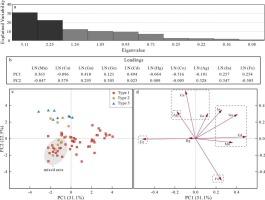LA-ICP-MS trace element geochemistry and sulfur isotopic compositions of sphalerite from Jiama deposit: Implications for its genesis and mineralization processes
IF 3.6
2区 地球科学
Q1 GEOLOGY
引用次数: 0
Abstract
The Jiama copper polymetallic deposit is a typical representative of the post-collision porphyry copper deposits in the eastern segment of the Gangdese metallogenic belt in China. Currently, the occurrence mechanism of the trace elements in sphalerite and the genesis of the distal lead–zinc mineralization are not clear in the Jiama deposit. Sphalerites, the primary ore minerals in the Jiama distal lead–zinc mineralization, have rich colors and are hosted in skarn (Sp1), hornfels (Sp2), and manto (Sp3) orebodies. In this study, we utilized laser ablation inductively coupled plasma mass spectrometry (LA-ICP-MS) and in-situ sulfur isotope analysis to investigate the genesis of sphalerite and reveal the distal lead–zinc mineralization processes. Sp1 had high Fe and Cd contents, Sp2 had low Mn and Ga contents, and Sp3 had high Cu and Co contents. The trace elements in sphalerite (e.g., Fe, Mn, Cd, Co, Ga, In, and Cu) primarily existed in the form of isomorphic substitution. The substitution mechanisms mainly included (Fe, Mn, Cd) 2+ ↔ Zn2+, (Cu+, Ag+) + Ga3+ ↔ 2Zn2+, and Cu+ + In3+ ↔ 2Zn2+. The sphalerite showed a diverse array of colors; based on these colors, the sphalerites were classified into three categories: brown with high contents of Fe, Cd, Mn, and Ga (Type 1); yellow with Ge and Cu enrichment (Type 2); and dark blue with high Ag concentrations (Type 3). The sulfur in the sphalerite in the Jiama deposit was derived from magma; this sphalerite generally formed under medium-to-high temperatures and moderate sulfur fugacity conditions. As the ore-forming fluids moved away from the hydrothermal center, the temperature and sulfur fugacity of the sphalerite formation gradually decreased, accompanied by a reduction in the Fe and Cd content of sphalerite. Thus, sphalerite can be utilized as one of the prospecting indicators for identifying the fluid source of porphyry mineralization systems.

甲玛闪锌矿LA-ICP-MS微量元素地球化学和硫同位素组成及其成因和成矿作用
甲玛铜多金属矿床是中国冈底斯成矿带东段碰撞后斑岩型铜矿床的典型代表。目前,甲玛矿床闪锌矿中微量元素的赋存机制及远端铅锌成矿成因尚不清楚。闪锌矿是甲马远端铅锌成矿的主要矿石矿物,颜色丰富,赋有矽卡岩(Sp1)、角砾(Sp2)和曼托(Sp3)矿体。本研究利用激光烧蚀电感耦合等离子体质谱(LA-ICP-MS)和原位硫同位素分析对闪锌矿成因进行了研究,揭示了远端铅锌成矿过程。Sp1的Fe和Cd含量高,Sp2的Mn和Ga含量低,Sp3的Cu和Co含量高。闪锌矿中的微量元素(Fe、Mn、Cd、Co、Ga、in、Cu等)主要以同构取代形式存在。替代机制主要有(Fe, Mn, Cd) 2+↔Zn2+、(Cu+, Ag+) + Ga3+↔2Zn2+和cu++ In3+↔2Zn2+。闪锌矿显示出各种各样的颜色;根据这些颜色,将闪锌矿分为三类:棕色闪锌矿,铁、镉、锰、镓含量高(1型);黄色含Ge和Cu富集(2型);深蓝色,银浓度高(3型)。甲玛矿床闪锌矿中的硫来源于岩浆;该闪锌矿一般形成于中高温和中等硫逸度条件下。随着成矿流体远离热液中心,闪锌矿地层温度和硫逸度逐渐降低,闪锌矿中Fe和Cd含量降低。因此,闪锌矿可作为识别斑岩成矿系统流体来源的找矿标志之一。
本文章由计算机程序翻译,如有差异,请以英文原文为准。
求助全文
约1分钟内获得全文
求助全文
来源期刊

Ore Geology Reviews
地学-地质学
CiteScore
6.50
自引率
27.30%
发文量
546
审稿时长
22.9 weeks
期刊介绍:
Ore Geology Reviews aims to familiarize all earth scientists with recent advances in a number of interconnected disciplines related to the study of, and search for, ore deposits. The reviews range from brief to longer contributions, but the journal preferentially publishes manuscripts that fill the niche between the commonly shorter journal articles and the comprehensive book coverages, and thus has a special appeal to many authors and readers.
 求助内容:
求助内容: 应助结果提醒方式:
应助结果提醒方式:


